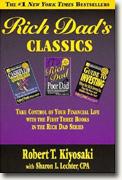Rich Dad's Classics
Robert T. Kiyosaki
book reviews:
· general fiction
· chick lit/romance
· sci-fi/fantasy
· graphic novels
· nonfiction
· audio books
· author interviews
· children's books @
curledupkids.com
· DVD reviews @
curledupdvd.com
newsletter
win books
buy online
links
home
for authors
& publishers
for reviewers

 |
Rich Dad's Classics: Boxed Set Robert T. Kiyosaki Warner Business Books Paperback 863 pages/3 books September 2005 |
|
Robert T. Kiyosaki was able to retire rich at age 47 and lead a life of leisure. In his 1997 book, Rich Dad, Poor Dad, he chronicled his modus operandi. Apparently, education was not a means to get rich. In fact, in his story, his educated father was the “Poor Dad.” The “Rich Dad” was his friend Mike’s father, a self-employed businessman who owned a variety of businesses after dropping out of high school. Kiyosaki’s book found a vast audience and made publishing history. He co-wrote two other books, Rich Dad’s Cashflow Quadrant and Rich Dad’s Guide to Investing, that further developed his approach to financial success. All three books have been packaged together in a “slipcase” edition and reissued by the publisher.
While Kiyosaki introduces various financial ideas (particularly the cashflow quadrant with its four ways to obtain income) to the financial novice, unfortunately, there is not much specificity in any of the three books. The Guide to Investing, for example, talks at length about real estate investing without really helping the would-be investor in getting started. It is more of a “this is my philosophy” book than a guide to financial success. For many people, education leads to great opportunities and personal satisfaction. Also, not all educated people fall into what Kiyosaki calls the “financial trap” of endless mortgages and continuing debt. By the same token, not all business people and investors are wealthy. Kiyosaki tends to oversimplify important things in order to make his point. While readers can enjoy his numerous anecdotes and imbibe his basic philosophy with regards to money, they should apply caution before acting on his ideas. Originally published on Curled Up With A Good Book at www.curledup.com. © Ram Subramanian, 2005 |
|
|
|
 Click here to learn more about this month's sponsor! |
|
| fiction · sf/f · comic books · nonfiction · audio newsletter · free book contest · buy books online review index · links · · authors & publishers reviewers |
|
| site by ELBO Computing Resources, Inc. | |
 Kiyosaki’s central thesis is that employment – working for somebody for a regular paycheck – gradually but surely draws the person into a financial hole, where each pay hike makes the person get into additional debt that becomes increasingly difficult to pay off during a lifetime. The subtext is that education draws one to seek employment and is bad because it leads to wrong financial decisions in life. The answer is to avoid this trap by becoming a businessman, and ultimately an investor, by having your money work for you. Kiyosaki is a big proponent of real estate, mainly because of its infinite possibilities to generate passive income. Told in a story form in simple, easy writing style and oft repeated phrases and ideas, the book attempts to provide a financial map for those who need navigation.
Kiyosaki’s central thesis is that employment – working for somebody for a regular paycheck – gradually but surely draws the person into a financial hole, where each pay hike makes the person get into additional debt that becomes increasingly difficult to pay off during a lifetime. The subtext is that education draws one to seek employment and is bad because it leads to wrong financial decisions in life. The answer is to avoid this trap by becoming a businessman, and ultimately an investor, by having your money work for you. Kiyosaki is a big proponent of real estate, mainly because of its infinite possibilities to generate passive income. Told in a story form in simple, easy writing style and oft repeated phrases and ideas, the book attempts to provide a financial map for those who need navigation.